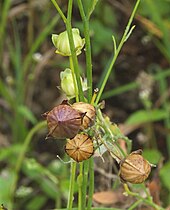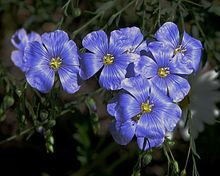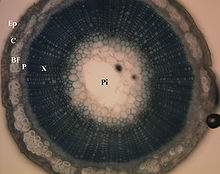| Flax | |
|---|---|
 | |
| Flax plant | |
| Scientific classification | |
| Kingdom: | Plantae |
| (unranked): | Angiosperms |
| (unranked): | Eudicots |
| (unranked): | Rosids |
| Order: | Malpighiales |
| Family: | Linaceae |
| Genus: | Linum |
| Species: | L. usitatissimum |
| Binomial name | |
| Linum usitatissimum Linnaeus. | |
Flax (also known as common flax or linseed) (binomial name: Linum usitatissimum) is a member of the genus Linum in the family Linaceae. It is native to the region extending from the eastern Mediterranean to India and was probably first domesticated in the Fertile Crescent. Flax was extensively cultivated in ancient Ethiopia and ancient Egypt.[1] A discovery reported in 2009 of spun, dyed, and knotted wild flax fibers in a prehistoric cave in the Republic of Georgia shows that the plant was already in use by humans at the surprisingly early date of 30,000 B.C.[2][3] New Zealand flax is not related to flax but was named after it, as both plants are used to produce fibers.
Contents[hide] |
[edit]Description
Flax is an erect annual plant growing to 1.2 m (3 ft 11 in) tall, with slender stems. The leaves are glaucous green, slender lanceolate, 20–40 mm long and 3 mm broad. Theflowers are pure pale blue, 15–25 mm diameter, with five petals; they can also be bright red. The fruit is a round, dry capsule 5–9 mm diameter, containing several glossy brown seeds shaped like an apple pip, 4–7 mm long.
In addition to referring to the plant itself, the word "flax" may refer to the unspun fibers of the flax plant.
[edit]History
Flax fibers are amongst the oldest fiber crops in the world. The use of flax for the production of linen goes back at least to ancient Egyptian times. Dyed flax fibers found in a cave in Dzudzuana (prehistoric Georgia) have been dated to 30,000 years ago.[4] Pictures on tombs and temple walls at Thebes depict flowering flax plants. The use of flax fiber in the manufacturing of cloth in northern Europe dates back toNeolithic times. In North America, flax was introduced by the Puritans.[citation needed]
[edit]Uses
Flax is grown for its use as an edible oil, as a nutritional supplement, and as an ingredient in many wood finishing products. Flax is also grown as an ornamental plant in gardens. Flax fibers are used to make linen. The Latin species name usitatissimum means most useful, pointing to the several traditional uses of the plant and their importance for human life.
Flax fibers
Flax fiber is extracted from the bast or skin of the stem of the flax plant. Flax fiber is soft, lustrous and flexible; bundles of fiber have the appearance of blonde hair, hence the description "flaxen". It is stronger than cottonfiber but less elastic. The best grades are used for linen fabrics such as damasks, lace and sheeting. Coarser grades are used for the manufacturing of twine and rope. Flax fiber is also a raw material for the high-quality paper industry for the use of printed banknotes androlling paper for cigarettes and tea bags. Flax mills for spinning flaxen yarn were invented byJohn Kendrew and Thomas Porthouse of Darlington in 1787.[21] New methods of processing flax and the rising price of cotton have led to renewed interest in the use of flax as an industrial fiber. Naturally Advanced's Crailar technology is one proprietary method that is increasing the industrial adoption of this plant.[22]
[edit]Cultivation
The significant linseed producing countries are Canada (~34%) and China (~25.5%), though there is also production in India (~9%), USA (~8%), Ethiopia (~3.5%) and throughoutEurope. Almost all of the United States crop is from the states of North Dakota, South Dakota, Minnesota, and Montana.[23]
The soils most suitable for flax, besides thealluvial kind, are deep loams, and containing a large proportion of organic matter. It is often found just above the waterline in cranberry bogs. Heavy clays are unsuitable, as are soils of agravelly or dry sandy nature. Farming flax requires few fertilizers or pesticides. Within 8 weeks of sowing, the plant will reach 10–15 cm in height, and will grow several centimeters per day under its optimal growth conditions, reaching 70–80 cm within fifteen days.
[edit]Production
2011 production in the United States was 70,890 Metric Tons,[24] 2007 was 149,970 Metric Tons,[25] 2006 production was 279,900 Metric Tons [26] Production of linseed in Russia in 2011: 230,000 metric tons according to FAO unofficial estimage [27]
| Top five linseed producers — 2007[28] | ||||
|---|---|---|---|---|
| Country | Production (metric tons) | Footnote | ||
| 633,500 | ||||
| 47,490 | ||||
| 45,000 | * | |||
| 41,000 | F | |||
| 34,000 | ||||
| World | 1,875,018 | A | ||
| No symbol = official figure, P = official figure, F = FAO estimate, * = Unofficial/Semi-official/mirror data, C = Calculated figure A = Aggregate (may include official, semi-official or estimates) | ||||
[edit]
Maturation
Flax is harvested for fiber production after approximately 100 days, or a month after the plant flowers and two weeks after the seed capsules form. The base of the plant will begin to turn yellow. If the plant is still green the seed will not be useful, and the fiber will be underdeveloped. The fiber degrades once the plant is brown.
[edit]Harvesting methods
There are two ways to harvest flax, one involving mechanized equipment (combines), and a second method, more manual and targeted towards maximizing the fiber length.
[edit]Mechanical
The mature plant is cut with mowing equipment, similar to hay harvesting, and raked into windrows. When dried sufficiently, a combine then harvests the seeds similar to wheat or oat harvesting. The amount of weeds in the straw affects its marketability, and this coupled with market prices determined whether the farmer chose to harvest the flax straw. If the flax was not harvested, it was typically burned, since the straw stalk is quite tough and decomposes slowly (i.e., not in a single season), and still being somewhat in a windrow from the harvesting process, the straw would often clog up tillage and planting equipment. It was common, in the flax growing regions of western Minnesota, to see the harvested flax straw (square) bale stacks start appearing every July, the size of some stacks being estimated at 10-15 yards wide by 50 or more yards long, and as tall as a two-story house.[citation needed]
[edit]Manual
The mature plant is pulled up with the roots (not cut), so as to maximize the fiber length. After this, the flax is allowed to dry, the seeds are removed, and is then retted. Dependent upon climatic conditions, characteristics of the sown flax and fields, the flax remains on the ground between two weeks and two months for retting. As a result of alternating rain and the sun, an enzymatic action degrades the pectins which bind fibers to the straw. The farmers turn over the straw during retting to evenly rett the stalks. When the straw is retted and sufficiently dry, it is rolled up. It will then be stored by farmers before scutching to extract fibers.
Flax grown for seed is allowed to mature until the seed capsules are yellow and just starting to split; it is then harvested by combine harvester and dried to extract the seed.
[edit]Threshing flax
Threshing is the process of removing the seeds from the rest of the plant. As noted above in theMechanical section, the threshing could be done in the field by a machine, or in another process, a description of which follows:
The process is divided into two parts: the first part is intended for the farmer, or flax-grower, to bring the flax into a fit state for general or common purposes. This is performed by three machines: one for threshing out the seed, one for breaking and separating the straw (stem) from the fiber, and one for further separating the broken straw and matter from the fiber. In some cases the farmers thrash out the seed in their own mill and therefore, in such cases, the first machine will be unnecessary.
The second part of the process is intended for the manufacturer to bring the flax into a state for the very finest purposes, such as lace, cambric, damask, and very fine linen. This second part is performed by the refining machine only.
The threshing process would be conducted as follows:
- Take the flax in small bundles, as it comes from the field or stack, and holding it in the left hand, put the seed end between thethreshing machine and the bed or block against which the machine is to strike; then take the handle of the machine in the right hand, and move the machine backward and forward, to strike on the flax, until the seed is all threshed out.
- Take the flax in small handfuls in the left hand, spread it flat between the third and little finger, with the seed end downwards, and the root-end above, as near the hand as possible.
- Put the handful between the beater of the breaking machine, and beat it gently till the three or four inches, which have been under the operation of the machine, appear to be soft.
- Remove the flax a little higher in the hand, so as to let the soft part of the flax rest upon the little finger, and continue to beat it till all is soft, and the wood is separated from the fiber, keeping the left hand close to the block and the flax as flat upon the block as possible.[citation needed]
- The other end of the flax is then to be turned, and the end which has been beaten is to be wrapped round the little finger, the root end flat, and beaten in the machine till the wood is separated, exactly in the same way as the other end was beaten.
[edit]Preparation for spinning
Before the flax fibers can be spun into linen, they must be separated from the rest of the stalk. The first step in this process is called retting. Retting is the process of rotting away the inner stalk, leaving the outer fibers intact. At this point there is still straw, or coarse fibers, remaining. To remove these the flax is "broken," the straw is broken up into small, short bits, while the actual fiber is left unharmed, then "scutched," where the straw is scraped away from the fiber, and then pulled through "hackles," which act like combs and comb the straw out of the fiber.
[edit]Retting flax
There are several methods of retting flax. It can be retted in a pond, stream, field or a tank. When the retting is complete the bundles of flax feel soft and slimy, and quite a few fibers are standing out from the stalks. When wrapped around a finger the inner woody part springs away from the fibers.
Pond retting is the fastest. It consists of placing the flax in a pool of water which will not evaporate. It generally takes place in a shallow pool which will warm up dramatically in the sun; the process may take from only a couple days to a couple weeks. Pond retted flax is traditionally considered lower quality, possibly because the product can become dirty, and easily over-retts, damaging the fiber. This form of retting also produces quite an odor.
Stream retting is similar to pool retting, but the flax is submerged in bundles in a stream or river. This generally takes longer than pond retting, normally by two or three weeks, but the end product is less likely to be dirty, does not smell as bad and, because the water is cooler, it is less likely to be over-retted.
Both Pond and Stream retting were traditionally used less because they pollute the waters used for the process.
Field retting is laying the flax out in a large field, and allowing dew to collect on it. This process normally takes a month or more, but is generally considered to provide the highest quality flax fibers,[citation needed] and produces the least pollution.
Retting can also be done in a plastic trash can or any type of water tight container of wood, concrete, earthenware or plastic. Metal containers will not work, as an acid is produced when retting, and it would corrode the metal. If the water temperature is kept at 80°F, the retting process under these conditions takes 4 or 5 days. If the water is any colder then it takes longer. Scum will collect at the top and an odor is given off the same as in pond retting. Currently 'enzymatic' retting of flax is being researched as a retting technique to engineer fibers with specific properties (Foulk Akin Dodd (2008). "Pectinolytic enzymes and retting," BioResources 3(1), 155-169) (Foulk Akin Dodd (2001) "Processing techniques for improving enzyme-retting of flax," Industrial Crops and Products 13 (2001) 239–248).
[edit]Dressing the flax
Dressing the flax is the term given to removing the straw from the fibers. Dressing consists of three steps: breaking, scutching, and heckling. The breaking breaks up the straw, then some of the straw is scraped from the fibers in the scutching process, then the fiber is pulled through heckles to remove the last bits of straw.
The dressing is done as follows:
- Breaking: The process of breaking breaks up the straw into short segments. To do it, take the bundles of flax and untie them. Next, in small handfuls, put it between the beater of the breaking machine (a set of wooden blades that mesh together when the upper jaw is lowered, which look like a paper cutter but instead of having a big knife it has a blunt arm), and beat it till the three or four inches that have been beaten appear to be soft. Move the flax a little higher and continue to beat it till all is soft, and the wood is separated from the fiber. When half of the flax is broken, hold the beaten end and beat the rest in the same way as the other end was beaten, till the wood is separated.
- Scutching: In order to remove some of the straw from the fiber, it helps to swing a wooden scutching knife down the fibers while they hang vertically, thus scraping the edge of the knife along the fibers and pull away pieces of the stalk. Some of the fiber will also be scutched away, this cannot be helped and is a normal part of the process.
- Heckling: In this process the fiber is pulled through various different sized heckling combs or heckles. A heckle is a bed of "nails" - sharp, long-tapered, tempered, polished steel pins driven into wooden blocks at regular spacing. A good progression is from 4 pins per square inch, to 12, to 25 to 48 to 80. The first three will remove the straw, and the last two will split and polish the fibers. Some of the finer stuff that comes off in the last hackles is called "tow" and can be carded like wool and spun. It will produce a coarser yarn than the fibers pulled through the heckles because it will still have some straw in it.
[edit]Genetically modified flax contamination
In September 2009 it was reported that Canadian flax exports had been contaminated by a de-registered genetically modified (GM) variety, known as Triffid. Triffid had food and feed safety approval in both Canada and the U.S. However, Canadian growers and the Flax Council of Canada had raised concerns about the marketability of this variety in Europe. The variety was subsequently de-registered in 2001 and never grown commercially in Canada or the U.S. All stores of the seed were purportedly crushed or destroyed. Despite these precautions flax exports were found to contain traces of this transgenic flax variety which resulted in problems for Canada's flax growers and the industry at large, who export 70% of their product to Europe. The EU currently has a zero tolerancepolicy regarding unapproved GMOs.[29]
[edit]As a symbolic image
Flax is the emblem of Northern Ireland and used by the Northern Ireland Assembly. In a coronet, it appeared on the reverse of theBritish one pound coin to represent Northern Ireland on coins minted in 1986 and 1991. Flax also represents Northern Ireland on the badge of the Supreme Court of the United Kingdom and on various logos associated with it.
Common flax is the national flower of Belarus.
In early tellings of the Sleeping Beauty tale, such as Sun, Moon, and Talia by Giambattista Basile, the princess pricks her finger not on a spindle but on a sliver of flax, which is later sucked out by her children conceived as she sleeps.
[edit]See also
<iframe width="560" height="315" src="http://www.youtube.com/embed/bAvUrj-Yq6s?list=PL59D6768621861170" frameborder="0" allowfullscreen></iframe>













